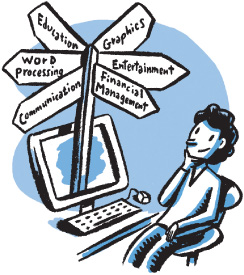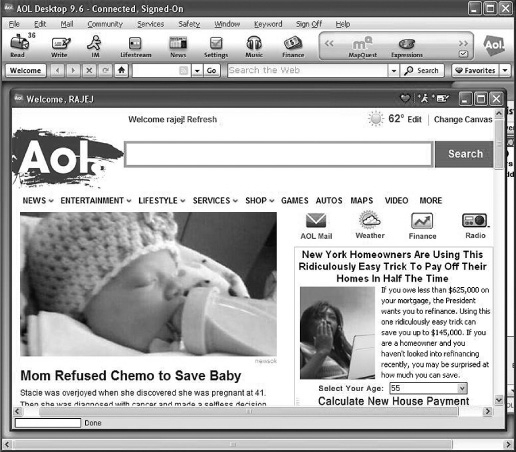

What software and Internet services fit you best
With the test-drive behind you, we can now discuss your software options. However, before we talk further about software, you might want to review Chapter 3, which gives an explanation of software and how it is used.
Regardless of whether you buy a desktop or a laptop, a PC or a Mac, your computer will already have the operating software stored in its brain. Even though the operating software on a PC is different than on a Mac, both offer some features that let you get started right away. However, these are bare-bones features. You will probably want to investigate adding some application software to your computer at the time of purchase or shortly thereafter. (Remember: Application software enables you to type a letter, design a website, chart your family genealogy, and much more.)
Often, the manufacturer of your computer will have already added some application software to your computer. Just to toss some jargon your way, a salesperson might say, “Your computer already has software loaded on it.” That means some application software has already been installed on your computer.
Each computer is different in what may be preinstalled, but usually there will be some kind of word-processing software. It may not be Microsoft Word, Microsoft Works, or Apple Works, but there will likely be at least some kind of Notepad or WordPad program, which allows for simple formatting of a document. Sometimes financial management software (such as Quicken) and often some fun stuff (simulated golf, Solitaire, etc.) will also be preinstalled on a new computer. This preinstalled application software is also referred to as “bundled software.”
“My son bought me software so that I could create a family tree and track our genealogy. It is marvelous. Once I’m done I’ll be able to give copies to all the kids.”
—Martina
When a store offers to sell you a computer “bundled” with software, it may sound convenient, but it does have a downside. When you do not buy the software outright—by that I mean you actually own the installation disk—you may have trouble getting technical assistance if you need it. Each set of installation disks has a serial or registration number. With this number the manufacturer confirms that you have purchased the software and will then offer you technical assistance. This is how manufacturers protect themselves against people who have “pirated” software (not bought, but borrowed and installed).
It is tempting when someone offers to bundle software with your computer purchase. However, I strongly advise that you consider making the extra investment of buying the software to have the security of technical assistance, in case you need it.
Some software manufacturers also offer a “trial version” of their software that is preinstalled on the computer at the time of purchase. At the end of the trial period you sign up and pay for the software online and it is yours to keep on the computer. The downside to this is that when you replace your computer you will have to purchase the software all over again because you don’t actually own the installation disks to install it on the new computer.
“My reason for wanting a computer was e-mail—I had no idea there were so many other things I could do with it.”
—Sonny
You may want to purchase some application software in addition to what your computer already has installed in it. Whatever application software you may be interested in, here are some things you should check out before you make a purchase.
Compatibility: You must make sure that the software is compatible with your computer. On the outside of the software box, it will indicate which operating system it is friendly with (Mac 10.6, Windows 7, Windows XP, etc.). Make sure your operating system is listed. The manufacturer should also post how much space, speed, and RAM it needs to operate properly. (When you buy your computer, you’ll record the size of your hard drive and the speed of your CPU. Always have it handy when you go shopping for software.)
Popularity: It’s valuable to find out what the top-selling software is. It still may not be the right choice for you, but there is a reason why it is so popular. Ask your salesperson why a particular software dominates the market.
Friends and Family: Again, if your friends or family have computers, ask which software they’re using and why. Have they been happy with it? Can they do a little show-and-tell for you? Keep in mind that people are very loyal to their choice of software. This sense of loyalty should not convince you; the performance of the software should.
Pull Out Those Magazines: The same magazines that listed the top ten computers to buy will also list the top ten software products.
Salespeople: Ask them about software products and have them give you a demonstration. They really do have your best interests in mind. Also ask if they can install it for you and what that will cost. Installing software isn’t difficult to do on your own, but if you buy it at the same time you buy your computer, the store may install it for you as a courtesy.
Help: Find out if the software manufacturer offers technical support. Is it free? For how long is it free? Some software manufacturers offer free support for the first 90 days after purchase. If that is the case, it’s a good idea to play with the software right away to get out any bugs and take advantage of the free help.
Cost: Some software is surprisingly expensive. If it seems out of your price range, ask your salesperson if he or she can recommend something similar without all the bells and whistles. The same manufacturer that designed the expensive software may offer a pared-down version for substantially less.
The modem is the hardware that allows you to connect to the Internet, but, if you’re using a dial-up connection, you’ll also need specific software. Many companies supply software to connect your computer, via the modem, to the outside world. These companies are called “online services,” and they provide you with access to e-mail and the Internet.
Your computer manufacturer (for both Mac and PC) may have included application software for several online services preinstalled on your hard drive. Some of the more popular companies may be familiar to you—America Online, Microsoft Network (MSN), and EarthLink, to name a few.
If you’ve chosen to use DSL or cable for your high-speed connection, the company providing that connection will give you the necessary software or may even come to your home and install it for you. A high-speed connection is much faster than using dial-up, and now the price tag isn’t much higher.

• America Online’s (AOL) Welcome Page.
When the time comes, you will sign on to one of these providers by using a credit card, which will be automatically charged each month for your subscription to their service unless your phone or cable company adds the cost directly to your monthly bill. Right now the average cost of unlimited use can be as low as $15 a month or as high as $40.
This decision is subjective. There is no dial-up or high-speed service that is “the best.” Again, signing on to a service that your friends and family use is always smart in case you need some help.
With any of these services it’s a good idea to call their technical support number and see how long you are kept on hold. Inevitably you will need to call them with a question, and if they are impossible to reach, that could be a factor in your decision-making process.
My mother uses a local online service. AT&T offered her a good deal on a high-speed connection, and she’s been very happy with it. Her monthly subscription charges go on her phone bill rather than on her credit card. You may want to call your local phone or cable company to see what they have to offer.
The only application software decision that you need to make soon is which online service you want to use. All other software can be purchased over time. The decision about your online service isn’t such a big deal because that application software will be free and you can change your mind and use a different service at any time. Even if the services suggest it, I don’t recommend that you pay for six months or a year in advance in case you do change your mind.
A: Digital subscriber line. DSL offers a high-speed connection to the Internet.
Q: I get online services and e-mail services mixed up. Please clarify.
A: An online service connects your computer to the Internet. Some online services also offer e-mail service (including America Online [AOL], EarthLink). An e-mail service (for example, Yahoo, Gmail, Hotmail) allows you to send e-mail on the Internet, but doesn’t connect you to the Internet.
Q: What if I buy my computer and it doesn’t have operating software on it?
A: Well, if it didn’t have operating software on it, it wouldn’t turn on. Or, if it turned on, you wouldn’t be able to operate the computer. At that point you would return the computer for a replacement. Fortunately, it is extremely unlikely that this would ever happen.
Q: What are the pros and cons of downloading software rather than owning the CD?
A: Downloading or transferring software from a website onto your computer may be necessary if your computer doesn’t have a CD or DVD drive. Those of us with a CD or DVD drive usually have the choice of buying the actual software, so we own the physical CD or DVD, or we can choose to download the software from the Internet. The upside of downloading software is that it is instantaneous. The downside is that if your computer glitches and loses everything, you don’t have a CD to re-install from. You’ll also have to use your credit card online, which is an issue for some.